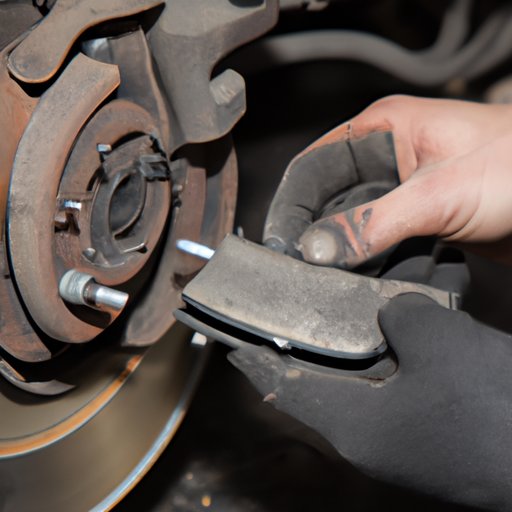
Introduction
Having properly functioning brake pads is crucial for safe driving. Brake pads grip the brake rotor in order to slow down or stop the vehicle, and worn or damaged brake pads can result in decreased stopping power and potential brake failure. In this article, we’ll educate readers on how to check, maintain, and replace brake pads to ensure their vehicle’s brakes are in good condition.
Step-by-Step Guide to Checking Brake Pads
Before beginning, it’s important to turn off the engine and engage the emergency brake for safety. Next, locate the brake pads – they are usually found behind the wheel on the front of the vehicle. Check each pad for thickness and look for cracks and wear. Examine the brake rotor for any visible damage or wear. If the thickness of the pad is less than a quarter inch, or if there are any signs of wear or damage, it’s time to replace the brake pads. A good rule of thumb is to have brake pads checked every 12 months or 12,000 miles, but you may need to have them checked more frequently if you drive in stop-and-go traffic or hilly areas.
Common Signs Your Brake Pads Need Replacing
If you hear squeaking or grinding noises when applying the brakes, or if the brake pedal vibrates when applying the brakes, these are common signs that your brake pads need replacing. If you notice any of these signs, it’s important to take your car to a mechanic as soon as possible. Ignoring these warning signs could result in costly repairs or even accidents.
Reducing the Cost of Maintaining Brake Pads
There are several ways you can prolong the life of your brake pads and reduce the overall cost of brake pad maintenance. One way is to avoid driving aggressively – hard, sudden stops can wear down brake pads more quickly. It’s also important to maintain a reasonable speed when driving and avoid excessive braking. Purchasing high-quality brake pads can also be a wise investment, as they tend to last longer and require less frequent replacement.
The Importance of Regularly Checking Brake Pads
Regularly checking brake pads is crucial for maintaining the safety and reliability of your vehicle. Driving with worn-out brake pads can lead to decreased stopping power and potential brake failure, which can be dangerous and costly to repair. It’s recommended to make brake pad checks a regular part of your vehicle maintenance routine.
DIY Brake Pad Replacement
If you feel confident and comfortable doing so, you can replace your own brake pads. However, it’s important to gather the necessary tools and to follow safety precautions, such as wearing gloves and eye protection. The steps involved in replacing brake pads may vary depending on the make and model of your vehicle, so it’s important to consult a repair manual or online resource for specific instructions.
Conclusion
Maintaining properly functioning brake pads is crucial for safe driving. It’s important to regularly check brake pads for wear and damage, as well as to know the common signs of worn brake pads. By following proper maintenance and replacement procedures, as well as safety precautions, you can ensure your vehicle’s brakes are in good condition to protect yourself and others on the road.





